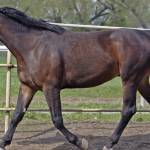Horse Splints

To understand splints, we need to remember that prehistoric ancestors of the modern horse had multiple toes on each foot. The horse of today walks on the tip of its middle toe, but vestigial traces of the other toes are still present. Two of these leftover toe bones, called splint bones, lie along the inner and outer sides of each cannon bone beginning just below the horse’s knee or hock and tapering to an end above the fetlock. The splint bones bear some weight and give support to the cannon bone.
In young horses, the interosseous ligament lying between the cannon bone and each splint bone is fairly elastic. In older horses, these ligaments harden and calcify, eventually turning the three separate bones into one.
How does a horse “pop a splint”?
An injury to the splint bone itself as well as any trauma that strains or tears the interosseous ligament will cause irritation. The result is a painful, swollen lump that can be seen and felt on the side of the horse’s leg below the knee or hock. At this point, the animal joins an extremely large fraternity of horses that have “popped a splint.”
In young horses, a splint is a frequent occurrence when training and exercise increase too rapidly. Although the horse has eight splint bones, two on each leg, those on the insides of the forelegs are most commonly affected because they are subject to the most strain. Too much exercise, excessive speed work, longeing in small circles, or any activity that involves twisting or pivoting on a foreleg can lead to irritation.
Can conformation play a role?
Anything that strains the weight-bearing structure of the leg can increase the risk of splints.
Misalignments in limb or hoof conformation, either congenital (bench-kneed, club-footed) or acquired (unbalanced shoeing, serious neglect of regular trimming schedule), might be partly to blame if a horse pops a splint.
Another problem, especially in toed-out horses, is interference in which a front hoof swings inward and hits the inside of the opposite cannon. Improper shoeing can alter the action of a correctly built horse, leading to the same type of interference and injury.
What about accidental causes?
Because no one wants to admit a horse has been pushed to the point of injury, some owners tend to blame the horse: “He popped that splint himself, just running out in the field.” While it’s not impossible for horses to injure themselves in the course of playing or racing around with their buddies, the majority of splints in young horses can probably be traced to the stress of training. A truly accidental cause is a kick from another horse, frequently on the outside of the lower leg that fractures the splint bone. Signs (pain, heat, and swelling) are similar to those of an interosseous ligament tear. Fracture of a splint bone can also be caused by the extreme stress involved in high-level performance.
How are splints treated?
Pain, swelling, heat, and lameness are the signs of a splint problem. Treatment is aimed at keeping the horse comfortable and allowing the injured ligament or bone to heal. Training and performance must be put on hold, and a veterinarian will often prescribe rest, either in a stall or in a restricted turn-out area, for several weeks or months until the inflammation resolves. Applying ice packs or hosing with cold water will help to reduce swelling and pain in a fresh splint. Pain medications and anti-inflammatories like bute may be prescribed. The use of topical ointments and counterirritants has not been proven to be advantageous, and use of blistering agents can lead to increased discomfort and scarring.
Signs should decrease gradually as healing takes place. A veterinarian can advise when it is safe to begin hand-walking, and eventually resume riding or driving. Although a small lump usually remains visible at the site of the injury, many splints never lead to additional trouble. Returning the horse to work before a splint is fully healed can cause a flare-up of pain and swelling, so a gradual reintroduction to exercise is advised.
Are all splints created equal?
Splints are so common that many people consider them to be only cosmetic blemishes, “unsightly but not unsound.” Most, indeed, do not cause the horse any pain or lameness once they heal, but there are a few exceptions.
Lingering trouble can occur when the calcification associated with a healed splint is in a position to irritate the suspensory ligament, which runs along the splint bone. Surgery is sometimes necessary to resolve the problem. Also, splints involving the upper part of the bone may be troublesome because the top of the splint bone forms part of the knee joint.
Any splint that doesn’t show improvement after a week or two of rest may be related to more than just a strained or irritated ligament, and a fracture is often suspected in these cases. If an x-ray reveals a broken splint bone, more time may be needed for healing, or surgical removal of the bone fragments can be considered.
Older horses sometimes reinjure the same area, even after healing seems to be complete, possibly because the horse is moving differently to reduce strain on another part of his body. If a pattern of recurring injury develops, it may be time to consider cutting back on the level of performance or even to retire the horse.
How can splints be prevented?
- Increase training or performance level gradually, especially with young horses or horses returning to work after a layoff.
- Use splint boots to prevent accidental injury caused by a horse hitting a hoof against the inside of the opposite leg.
- Follow a regular schedule of trimming and/or shoeing, and be sure the feet are level and balanced.
- Feed a fortified grain product with a balanced calcium-to-phosphorus ratio to encourage proper bone development.
- To avoid undue strain on bones and ligaments, don’t allow horses to become overweight.








